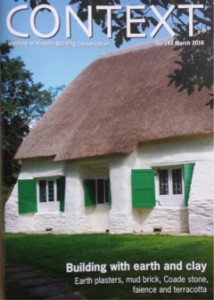 Terracotta, faience, Coade stone, mud brick and earth plasters are all covered the new issue of the IHBC members’ journal Context, as No. 143 covers building with earth, clay and more, while 400 copies are being presented to key sector partners for distribution at IHBC-sponsored events: Building Limes Forum conferences and to Earth Building UK for their 2016 Clayfest in Cumbria!
Terracotta, faience, Coade stone, mud brick and earth plasters are all covered the new issue of the IHBC members’ journal Context, as No. 143 covers building with earth, clay and more, while 400 copies are being presented to key sector partners for distribution at IHBC-sponsored events: Building Limes Forum conferences and to Earth Building UK for their 2016 Clayfest in Cumbria!
IHBC Director Seán O’Reilly said: ‘As the primary platform for presenting built and historic environment conservation in practice, our members’ journal Context embodies the broadest sector remit and offers some of the best multi-disciplinary CPD you can imagine. So it’s fitting that it serves also as our leading outreach tool to practitioner colleagues, and regularly we produce free copies for partner bodies to circulate to their own members at key events.’
‘This issue is no different, as both the Building Limes Forum, which does what it says, and Earth Building UK, organisers of the 2016 Clayfest, and both with IHBC as sponsors, will offer free copies of this issue for circulation at their major events and conferences.
On issue No 143 itself, Fiona Newton, IHBC acting Chair of the Editorial Board, said: ‘The world is full of people inventing new building materials and ingenious ways of using the latest technology to make buildings work. At the same time other people are rediscovering the wonders of some materials that have been around for thousands of years. This issue of Context, which focuses on building with earth and clay, and conserving what previous generations built with it, highlights how much there is to learn, and how much these ancient and fundamental materials have to offer.’
‘Building with earth is durable, fireproof and reusable. Firing it to make bricks and tiles was a local affair until the industrial revolution, when technology made those products more consistent and cheaper, and canals and railways slashed distances. Our brick-built towns and cities are the result. The ease of moulding terracotta provided a cheaper and mass-producible substitute for stone, with qualities of its own. Mrs Coade showed just how fine and robust clay-based artificial stone could be. Today, though, natural variations in colour, tone and texture do not come easily to modern kiln technology and production methods. With both repairs and replacements presenting difficulties, the size of terracotta’s conservation challenge is becoming ever more clear. Our new Context will introduce you, and inform you about, these ideas and standards, and many more.’
The articles within this issue include:
- Vernacular earthen architecture: Maria Yioutani-Iacovides
- Mud brick in Iran: Eisa Esfanjary
- Earth plasters and how to use them: Adam Weismann and Katy Bryce
- Understanding lime plaster: Philip Gaches
- Cleaning brickwork, faience and terracotta: Jamie Fairchild
- The influence of geology on English brickmaking: Andrew Bloodworth
- The taste for terracotta: Jonathan Taylor
- Restoring the Nelson’s Pediment Coade stone: Kimberly Reczek
- Conserving terracotta: John Fidler
- Thatching appeals: Alison Henry
- Breaking into heritage: Daniel Longman
The articles give a fascinating insight into the range of earth and clay materials used in the contemporary built environment worldwide, with excellent illustrations to demonstrate the application of this timeless technology.
As ever, themed issues of Context also include more general conservation articles as well as news, book reviews and reports from IHBC’s officers. Issues are posted online approximately six months after they are issued to members.
If you have any suggestions for Context articles or other material contact Fiona Newton at: editorial@ihbc.org.uk
View the Summer School Context edition and the Context archive, as well as information on Context’s future issues and guidance for authors HERE
For information on Context’s future issues, guidance for authors, and links to the journal’s archives see the IHBC website
